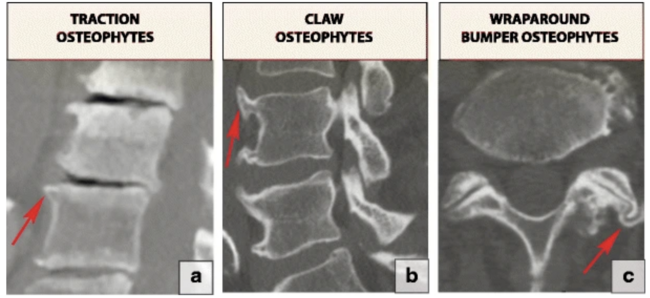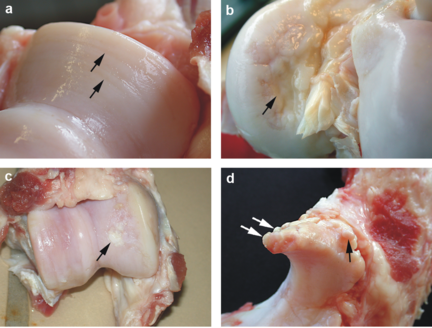Osteophyte: Difference between revisions
No edit summary |
No edit summary |
||
| Line 6: | Line 6: | ||
== Introduction == | == Introduction == | ||
Osteophytes are cartilage-capped bony proliferations (bony spurs) that most commonly develop at the margins of a synovial joint as a response to articular cartilage damage, as seen very commonly in osteoarthritis (OA).<ref name=":1">Radiopedia [https://radiopaedia.org/articles/osteophyte-2 Osteophyte] Available:https://radiopaedia.org/articles/osteophyte-2 (accessed 7.9.2022)</ref> | Osteophytes are cartilage-capped bony proliferations (bony spurs) that most commonly develop at the margins of a synovial joint as a response to articular cartilage damage, as seen very commonly in osteoarthritis (OA).<ref name=":1">Radiopedia [https://radiopaedia.org/articles/osteophyte-2 Osteophyte] Available:https://radiopaedia.org/articles/osteophyte-2 (accessed 7.9.2022)</ref> | ||
[[File:Osteophytes.png|center|thumb|650x650px|Three types of osteophytes related to the degenerative spine: (a) traction osteophytes (arrow), (b) claw osteophytes (arrow) and (c) wraparound bumper osteophytes (arrow)]] | |||
== Pathophysiology == | == Pathophysiology == | ||
| Line 20: | Line 21: | ||
== Differential Diagnosis == | == Differential Diagnosis == | ||
Enthesophyte: located at an attachment of a ligament or tendon, not associated with a joint.<ref name=":1" /> | # Syndesmophyte: paravertebral ossifications, run parallel with the spine cf. osteophytes which typically protrude perpendicular to the spine | ||
# Enthesophyte: located at an attachment of a ligament or tendon, not associated with a joint.<ref name=":1" /> | |||
== References == | == References == | ||
<references /> | <references /> | ||
Revision as of 06:11, 7 September 2022
Original Editor - Lucinda hampton
Top Contributors - Lucinda hampton, Nupur Smit Shah and Kim Jackson
Introduction[edit | edit source]
Osteophytes are cartilage-capped bony proliferations (bony spurs) that most commonly develop at the margins of a synovial joint as a response to articular cartilage damage, as seen very commonly in osteoarthritis (OA).[1]
Pathophysiology[edit | edit source]
Osteophytes are formed of fibrocartilage and bone, often forming at the peripheral margins of joints at the interface between cartilage and the periosteum. Osteophytes are thought to develop from chondrogenic differentiation of progenitor cells, commonly from within the periosteum. Osteophytes appear to be a cellular repair response to the altered growth factor environment following joint injury. In some cases osteophytes can contribute to the stability of the joints.[2]
Presentation[edit | edit source]
Osteophytes are most commonly found in the following areas. Neck, shoulder, knee, lower back, fingers or big toe, foot or heel. Osteophytes cause problems for example if they: cause friction if rubbing against footwear; impinge nerves such as an existing spinal root; restrict movement as may occur in hip and knee OA; limit space as in an impingement syndrome of the shoulder.[3]
Treatment[edit | edit source]
Osteophytes when causing issues, for example with OA, can be managed along side management of OA, See link here Osteoarthritis.
Removal of an osteophyte is not usual, unless it's irritating a nerve in the spine or restricting a joint's range of movement. If surgery is warranted, a surgeon will explain the procedure's risks and benefits.[3]
Differential Diagnosis[edit | edit source]
- Syndesmophyte: paravertebral ossifications, run parallel with the spine cf. osteophytes which typically protrude perpendicular to the spine
- Enthesophyte: located at an attachment of a ligament or tendon, not associated with a joint.[1]
References[edit | edit source]
- ↑ 1.0 1.1 Radiopedia Osteophyte Available:https://radiopaedia.org/articles/osteophyte-2 (accessed 7.9.2022)
- ↑ Firestein GS, Budd RC, Gabriel SE, McInnes IB, O'Dell JR. Kelley's Textbook of Rheumatology E-Book. Elsevier Health Sciences; 2012 Aug 31. Available:https://www.sciencedirect.com/topics/medicine-and-dentistry/osteophyte (accessed 7.9.2022)
- ↑ 3.0 3.1 NHS Osteophyte Available:https://www.nhs.uk/conditions/osteophyte/ (accessed 7.9.2022)








